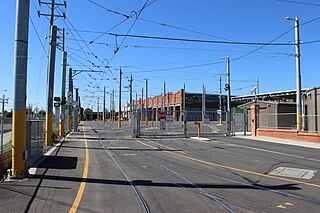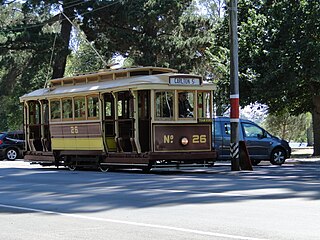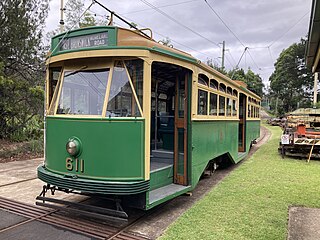Related Research Articles

Melbourne tram route 75 is operated by Yarra Trams on the Melbourne tram network from Vermont South to Central Pier. The 22.8 kilometre route is operated out of Camberwell depot with A and B class trams. It is the longest route on the network.

Melbourne tram route 70 is operated by Yarra Trams on the Melbourne tram network from Waterfront City to Wattle Park. The 16.5 kilometre route is operated out of Camberwell depot with A and B class trams.

Melbourne tram route 16 is operated by Yarra Trams on the Melbourne tram network from Melbourne University to Kew. The 20.2 kilometre route is operated out of Malvern depot with Z and D1 class trams.

The Colonial Tramcar Restaurant was a restaurant operating from a converted fleet of three vintage W class trams in Melbourne, Australia from 1982 until 2018.

Melbourne tram route 78 is operated by Yarra Trams on the Melbourne tram network from North Richmond to Balaclava. The 6.5 kilometre route is operated out of Kew depot with A class trams.

The Melbourne & Metropolitan Tramways Board (MMTB) was a government-owned authority that was responsible for the tram network in Melbourne, Australia between 1919 and 1983, when it was merged into the Metropolitan Transit Authority. It had been formed by the merger of a number of smaller tramway trusts and companies that operated throughout the city.

The Z-class are single-unit bogie trams that operate on the Melbourne tram network. Between 1975 and 1983, 230 trams spanning three sub-classes were built by Comeng, Dandenong. The design was based on two similar Gothenburg tram models, and a prototype built by the Melbourne & Metropolitan Tramways Board. While the Z1 and Z2-class trams were very similar, the Z3-class had significant design changes.

The W-class trams are a family of electric trams built by the Melbourne & Metropolitan Tramways Board (MMTB) between 1923 and 1956. Over the 33 years of production, 752 vehicles spanning 12 sub-classes were constructed, the majority at the MMTB's Preston Workshops.

Essendon tram depot is located on Mount Alexander Road, Travancore, a suburb of Melbourne, Victoria, Australia. Operated by Yarra Trams, it is one of eight tram depots on the Melbourne tram network. Despite the name, the depot is located three kilometres from the suburb of Essendon.

Camberwell tram depot is located on Council Street, Hawthorn East, a suburb of Melbourne, Victoria, Australia. Opened in December 1929, it is operated by Yarra Trams. It is one of eight tram depots on the Melbourne tram network.

Hawthorn tram depot was built in April 1916 by the Hawthorn Tramways Trust (HTT). It was built on the corner of Power Street and Wallen Road, Hawthorn, a suburb of Melbourne, Australia. It is also known as the Melbourne Tram Museum. The depot was close to the junction of the HTT's two main lines. It was taken over by the Melbourne & Metropolitan Tramways Board (MMTB) in 1920. In 1925, the depot was used as a school to teach tram drivers and tram conductors. In 1940, the building was also used to make uniforms for MMTB staff.

Preston Workshops is the heavy maintenance facility for the Melbourne tram network. The workshop is located on a block surrounded by Miller Street, St Georges Road, Oakover Road and the Mernda railway line in Preston, a suburb in Melbourne, Victoria, Australia. Following a major redevelopment in April 2016, it also became an operational depot under the name New Preston Depot, taking over from East Preston.

East Preston tram depot was a depot on the Yarra Trams network in Melbourne. Located on Plenty Road, East Preston, it opened in 1955 to coincide with the reintroduction of trams to Bourke Street. It closed in April 2016.

North Fitzroy tram depot was a depot on the Melbourne tram network. Located on Nicholson Street, North Fitzroy, it opened in 1956 when the Melbourne & Metropolitan Tramways Board converted part of its North Fitzroy bus depot for tramway operation when the Bourke Street to Brunswick East line reopened. In 1976 it became a sub-unit of East Preston depot. It was the smallest tram depot in Melbourne.

The M-class was a class of 17 trams built by Duncan & Fraser, Adelaide for the Hawthorn Tramways Trust (HTT) as numbers 1 to 10, and 33 to 39. All passed to the Melbourne & Metropolitan Tramways Board on 2 February 1920 when it took over the Municipal Tramway Trusts, becoming the M-class and being renumbered 107 to 116, and 183 to 189.
The X-class was a class of two Birney trams imported from United States manufacturers JG Brill Company and St Louis Car Company by the Melbourne & Metropolitan Tramways Board. In June 1924 both entered service from Hawthorn depot on the Power Street to Hawthorn Bridge service. In 1928 both were transferred to Glenhuntly depot to operate the Point Ormond route.
The X1-class was a class of ten trams built by the Melbourne & Metropolitan Tramways Board. Developed from the X-class, they differed in having four doors. They were initially allocated to Glenhuntly and Hawthorn depots. Six were transferred to the isolated Footscray network In June 1928 with the other four following in June 1929.
The X2-class was a class of six trams built by the Melbourne & Metropolitan Tramways Board. Developed from the X1-class, they differed in having larger wheels, angled windshields and only two doors.

The Y1-class was a class of four trams built by the Melbourne & Metropolitan Tramways Board built as a modified version of the Y-class to trial one man operation. Initially used on East and West Preston routes from Collins Street, from 1934 they were transferred to the Toorak line. From 1936 they were used on Burwood services from Camberwell depot. In 1933, 613 was used on Victorian Railways' Sandringham railway station to Black Rock line.
The Melbourne tram network began in 1884 with the construction of the Fairfield Horse Tramway. However, the purpose of the line was to increase land prices in the area, and it soon closed during the depression in 1890. The first genuine attempt to construct a tramway network was the construction of the Richmond cable tram line by the Melbourne Tramway & Omnibus Company in 1885. Over the next few years, 16 more cable tram lines were constructed, as well as numerous other horse tramways. The depression of the early 1890s slowed further expansion of the cable network. The first electric tram line was the Box Hill and Doncaster tramway which opened in 1889. This was a pioneering line in what was then the countryside and thus didn't receive much patronage. It closed in 1896. The next attempt at an electric tramway was Victorian Railways' St Kilda to Brighton line, which opened in 1906. Later that year, the North Melbourne Electric Tramway & Lighting Company opened lines to Essendon and Maribyrnong. Many local councils formed their own tramway trusts and built tramways within their own constituency. The most successful of these was the Prahran & Malvern Tramways Trust.
References
- ↑ "60 Years of the M&MTB" Trolley Wire issue 186 February 1980 page 14
- ↑ Cross, Norman; Budd, Dale; Wilson, Randall (1993). Destination City Melbourne's Electric Trams (5 ed.). Sydney: Transit Publishing Australia. p. 29. ISBN 0 909459 18 5.
- ↑ Y Class Archived 10 July 2017 at the Wayback Machine Vicsig
- ↑ "Hawthorn Depot Closed" Trolley Wire issue 97 April 1965 page 11
- ↑ "Melbourne Tram Notes" Trolley Wire issue 98 June 1965 page 13
- ↑ Melbourne & Metropolitan Tramways Board Y Class No 469 Archived 15 February 2017 at the Wayback Machine Melbourne Tram Depot